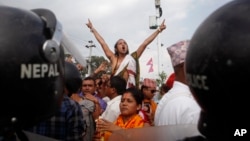After a decade of political infighting and violent protests, the long-awaited passage of Nepal's constitution should be a reason to celebrate.
But there are also signs that the Himalayan nation's first complete political framework since monarchy was abolished in 2006, could set the stage for prolonged conflict as some ethnic groups are protesting the charter.
The government sees the new constitution as a much-needed success for the nation of 28 million, still recovering from a devastating April 25 earthquake that killed thousands. The constitution, passed late Wednesday, sets the country up as a secular federation of seven states, each with a legislature and chief minister.
“The people have achieved a republican nation that they have aspired for decades,” Foreign Minister Mahendra Bahadur Pandey said.
However, some ethnic and religious groups say lawmakers ignored their concerns over how state borders should be defined. Some among majority Hindus also believe the country's reference as a Hindu nation should have been restored in the constitution.
Smaller opposition parties rejected the new constitution in a joint statement on Thursday, and announced a nationwide general strike on Sunday followed by protests where they will burn copies of the new charter.
‘Giving birth to a conflict’
“The constitution being rushed through is not giving positive indications,” analyst and former election commissioner Bhoj Raj Pokhrel said. “It is giving birth to a conflict. The grievances of those who oppose the constitution need to be immediately addressed by the state. The future of Nepal depends on how the state acts and reacts.”
Protests organized by two ethnic groups - the Tharu in southwestern Nepal and the Madhesi in the country's south and southeast - have shut down parts of Nepal for weeks. Authorities have imposed curfew and deployed security forces, but the protests and blockades still have slowed food and cargo deliveries by road to the capital, Kathmandu.
On Tuesday, police opened fire after a group of protesters attacked a 160-truck convoy, killing four people. The violence came amid weeks of protests that have left more than 44 people dead, including police officers.
The Madhesi groups have vowed to continue protesting.
“The big parties have tried to crush the minority groups and, as a result, pushed the nation into chaos,” said one Madheshi group leader, Shivaji Yadav of the Federal Socialist Forum.
He said their issues should have been resolved before the draft constitution was voted on.
“Speeding the process to push through the draft was not done to empower the people, but for the big leaders to come to power,” he said.
‘What the majority wants’
On the streets of Kathmandu, many Nepalese expressed relief that politicians set aside their differences and voted for the constitution.
“How long can the nation hold back on everything just because these politicians cannot reach agreement?” businessman Susil Shrestha said.
Teacher Bishnu Aryal said that an imperfect charter was still better than ongoing political uncertainty.
“We just can't get a constitution where everyone is happy,” Aryal said. “It is what the majority wants, and a few minorities cannot and should not hold the nation as hostage because of something they disagree with.”
Foreign Minister Pandey said there is room to discuss the ethnic groups' concerns. “We have left the door open for the talks, which is the only option to resolve the situation.”
The U.S. government urged security forces to exercise restraint in responding to protests and citizens against resorting to violence. Neighboring India also cautioned restraint and flexibility on the part of all political forces.





